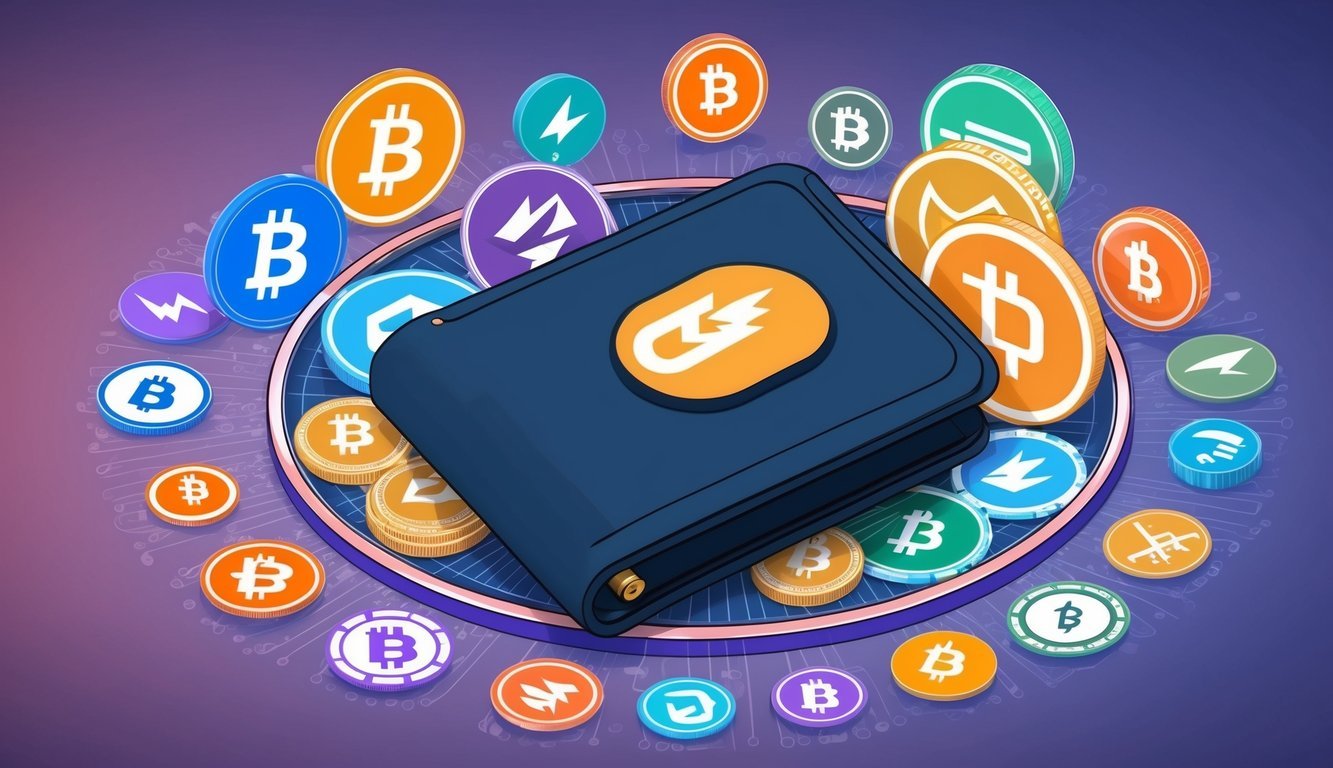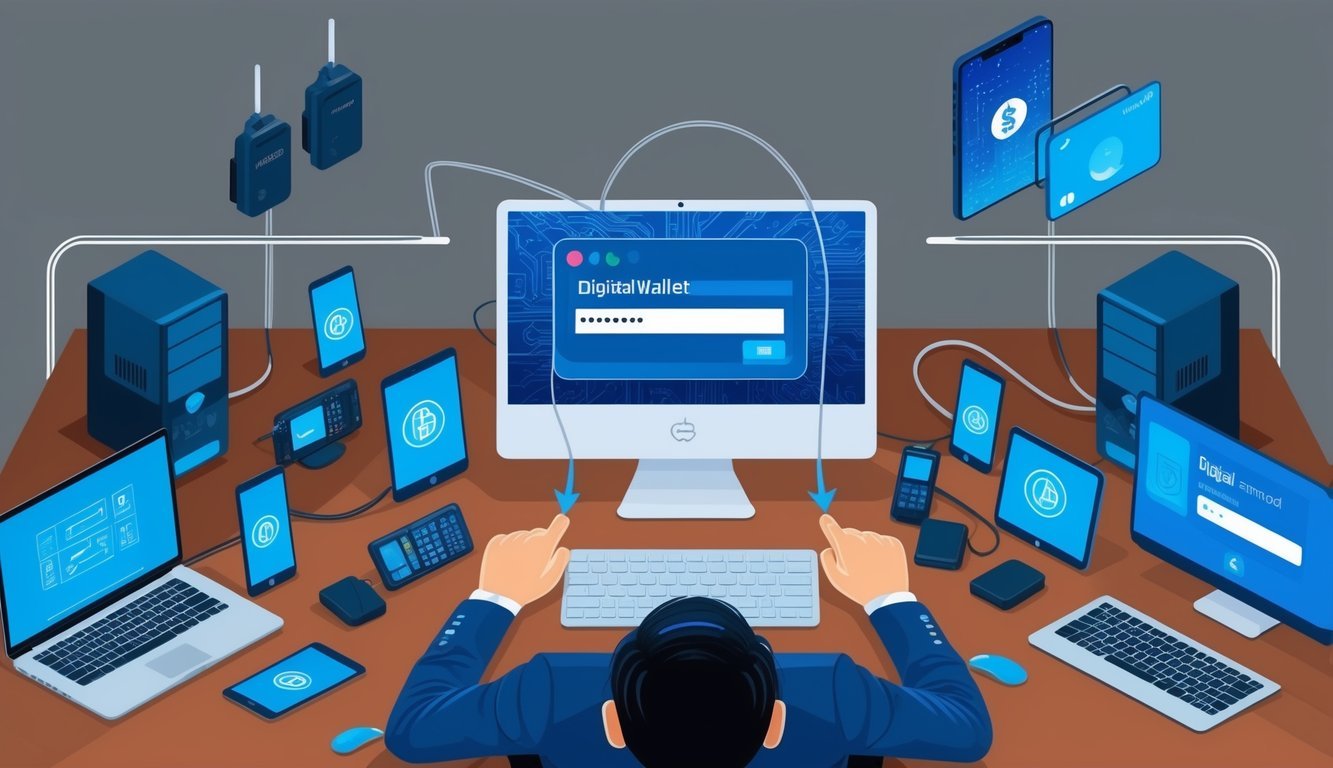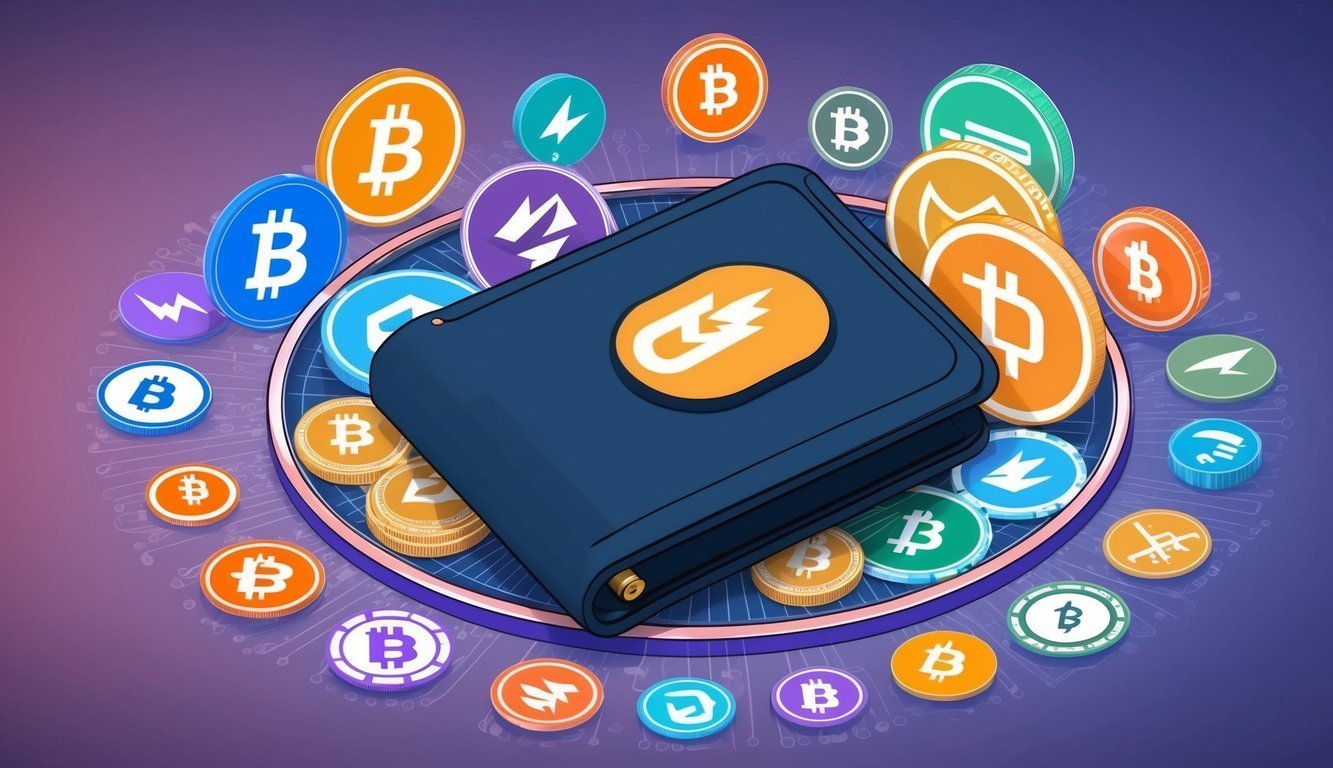Crypto wallets are digital tools that keep your cryptocurrency safe and easy to use. They’re like a mix between a bank account and a password manager for your digital money. A crypto wallet stores your private keys, which are secret codes that let you access and spend your cryptocurrency.

You can choose between two main types of wallets: hot and cold. Hot wallets connect to the internet, making it quick to buy or trade crypto. Cold wallets stay offline, which keeps your assets extra secure from online threats. Many people use both kinds to balance security and convenience.
Picking the right wallet depends on your needs. Some wallets work with lots of different cryptocurrencies, while others focus on just one or two. Some have fancy features like built-in exchanges or earning interest. You’ll want to think about what coins you own, how often you trade, and how much security you need.
Key Takeaways
- Crypto wallets protect your digital assets with private keys
- Hot wallets offer convenience, while cold wallets provide enhanced security
- Your ideal wallet choice depends on your trading habits and security needs
Understanding Crypto Wallets
Crypto wallets let you store and use digital money. They come in different types to fit your needs. Some are online, while others are physical devices. Let’s look at the main kinds of wallets and how they work.
Hot Wallets vs Cold Wallets
Hot wallets are always connected to the internet. They’re easy to use for quick trades. You can access them on your phone or computer. But they’re not as safe from hackers.
Cold wallets stay offline. They’re much safer from online threats. You only connect them when you need to make a trade. Hardware wallets are a popular type of cold wallet.
Here’s a quick comparison:
- Hot Wallets: Fast, convenient, less secure
- Cold Wallets: Slower, safer, better for long-term storage
Custodial vs Non-Custodial Wallets
Custodial wallets are like digital banks. A company holds your private keys for you. It’s easier, but you don’t have full control of your crypto.
Non-custodial wallets give you complete control. You manage your own private keys. It’s more work, but your crypto is truly yours.
Remember:
- Custodial: Easy to use, less control
- Non-custodial: More responsibility, full control
Hardware Wallets Explained
Hardware wallets are small devices that store your crypto offline. They look like USB sticks. These wallets keep your private keys safe from online threats.
To use a hardware wallet:
- Buy one from a trusted brand like Ledger or Trezor
- Set it up with a PIN
- Write down your recovery phrase
- Connect it to your computer only when you need to make a transaction
Hardware wallets are great for storing large amounts of crypto. They’re the safest option for long-term storage. But they cost money and aren’t as quick for daily use.
Securing Your Crypto Assets
Keeping your digital money safe is super important. You need to know about private keys, follow good security habits, and have a backup plan.
The Importance of Private Keys
Your private key is like the password to your crypto vault. It’s a long string of numbers and letters that proves you own your coins. Never share it with anyone!
Think of it as the key to your house. If someone gets it, they can take all your stuff. That’s why you need to guard it closely.
Some tips for protecting your private key:
- Write it down on paper (not on your computer)
- Store it in a safe place, like a locked drawer
- Consider using a hardware wallet to keep it offline
Security Measures and Best Practices
You can take steps to make your crypto wallet super secure. Here are some easy ways to protect your digital cash:
Use strong passwords for your accounts. Mix up letters, numbers, and symbols.
Turn on two-factor authentication (2FA). This adds an extra step when you log in.
Be careful about phishing scams. Don’t click weird links or give out info to strangers.
Keep your computer and phone updated. New updates often fix security problems.
Consider using a multi-signature wallet. This needs more than one person to approve transactions.
Recovery Phrases and Backups
Your recovery phrase is super important. It’s usually 12 or 24 words that can bring back your wallet if you lose access.
Write down your recovery phrase on paper. Don’t keep it on your computer or phone where it could get hacked.
Store it in a safe place. Some people use fireproof safes or bank deposit boxes.
Never share your recovery phrase with anyone. Scammers might try to trick you into giving it up.
Make multiple copies and keep them in different places. This way, you’re covered if something happens to one copy.
Remember, if you lose your recovery phrase, you might lose your crypto forever. So treat it like it’s worth a lot of money – because it is!
Wallet Integration and Usability
Crypto wallets are getting better at connecting with other services and apps. This makes them easier to use for all kinds of crypto tasks. Let’s look at how wallets work on different devices and link up with exchanges and DeFi.
Desktop and Mobile Wallets
Your crypto wallet experience can be quite different on desktop versus mobile. Desktop wallets like Ledger Live and Trezor Suite often have more features. They give you detailed control over your crypto.
Mobile wallets focus on quick, easy use. They’re great for on-the-go transactions. Many now work with Apple Pay, making crypto buys feel like normal shopping.
Some wallets, such as Coinbase Wallet and MetaMask, offer both desktop and mobile versions. This lets you manage your crypto from anywhere.
Integrations with Exchanges and DeFi Platforms
Modern crypto wallets don’t just store your coins. They connect to exchanges and DeFi platforms, making trading and investing simpler.
With these integrations, you can:
- Buy and sell crypto directly in your wallet
- Swap tokens without leaving the app
- Stake coins for rewards
- Lend your crypto or borrow against it
This saves you time and reduces the risk of mistakes when moving funds around.
User Experience and Accessibility
Wallet makers are working hard to make crypto easier for everyone. They’re focusing on:
- Clear, simple designs
- Easy backup and recovery options
- In-app guides and education
- Support for multiple languages
Custom fee options are becoming more common. This lets you choose between speed and cost for transactions.
Wallets are also adding features for users with disabilities. Larger text, voice commands, and screen reader support are improving accessibility.
The goal is to make managing your crypto as easy as using a regular banking app. As wallets get better, more people will feel comfortable using crypto.
Engaging with the Crypto Ecosystem

Crypto wallets are your gateway to a world of digital finance opportunities. They let you do more than just store coins – you can actively grow and manage your crypto assets in exciting ways.
Staking, Trading, and Investing
With your crypto wallet, you can jump into staking to earn rewards on your holdings. Many wallets connect to DeFi platforms where you can stake coins like Ethereum or Cardano.
Trading is a breeze too. Your wallet links to exchanges so you can swap tokens quickly. Some even have built-in trading features.
For investing, wallets help you track coin prices and your portfolio value. You can set up recurring buys to dollar-cost average into your favorite cryptos.
Just be careful – only invest what you can afford to lose. Crypto markets can be very volatile.
NFTs and Crypto Collectibles
Your wallet is also your ticket to the NFT world. You can buy, store, and show off digital art, collectibles, and more.
Some wallets have special NFT sections to view your collection. You might see your NFTs as images right in the wallet interface.
Wallets connect to NFT marketplaces too. This lets you browse and purchase new NFTs easily.
Want to create your own NFTs? Many wallets support minting functionality so you can make and sell your digital creations.
Portfolio Management and Tracking
Keeping tabs on your crypto investments is crucial. Good wallets offer built-in portfolio tracking tools.
You’ll see charts of your holdings over time and breakdowns by coin. Some wallets sync with external portfolio apps for even more detailed analysis.
Price alerts are handy too. Set them up to notify you of big market moves.
Many wallets integrate with DApps for advanced portfolio management. You might access lending protocols or yield farming opportunities directly through your wallet interface.
Frequently Asked Questions

Picking the right crypto wallet involves weighing security, ease of use, and supported coins. Hot wallets offer quick access, while cold storage provides enhanced security. Let’s dive into some common questions about crypto wallets.
How do I pick the best wallet for my crypto stash?
When choosing a wallet, think about your needs. Do you trade often? A mobile wallet might be best. Holding long-term? Consider a hardware wallet for extra safety.
Look at which coins the wallet supports. Some wallets work with many cryptocurrencies, while others focus on just a few.
Can you break down the difference between hot and cold wallets?
Hot wallets are connected to the internet. They’re easy to use for quick trades but more vulnerable to hacks.
Cold wallets, like hardware devices, stay offline. They’re safer but less convenient for frequent transactions.
Which wallet should a newbie use to get started with crypto?
For beginners, user-friendly software wallets are a good start. The Coinbase Wallet is popular for newcomers.
These wallets often have simple interfaces and built-in tutorials to help you learn the ropes.
Hey, what’s a safe spot to keep my digital coins?
The safest option is usually a hardware wallet. These devices store your crypto offline, away from internet threats.
For smaller amounts, a reputable software wallet with strong security features can also work well.
Wallet apps are all over the place – which one tops the charts?
Many users rate Exodus highly for its ease of use and wide coin support. It works on desktop and mobile.
Remember, the best wallet depends on your personal needs and the cryptocurrencies you use.
Is there a wallet that stands out for secure storage?
Hardware wallets like Ledger Nano X are known for top-notch security. They keep your private keys offline.
For a software option, look for wallets with features like two-factor authentication and regular security audits.




